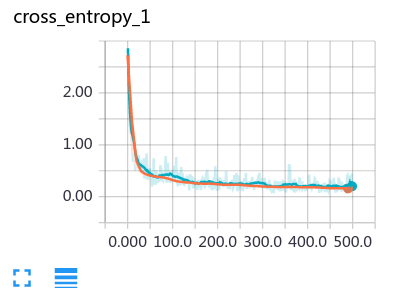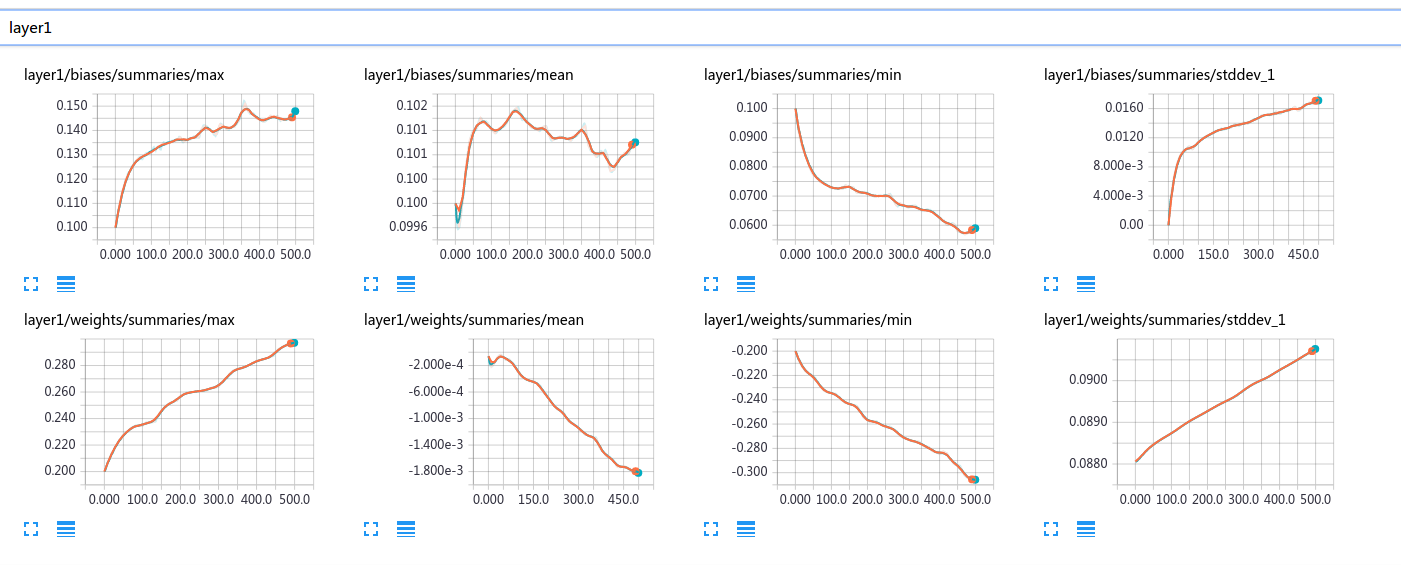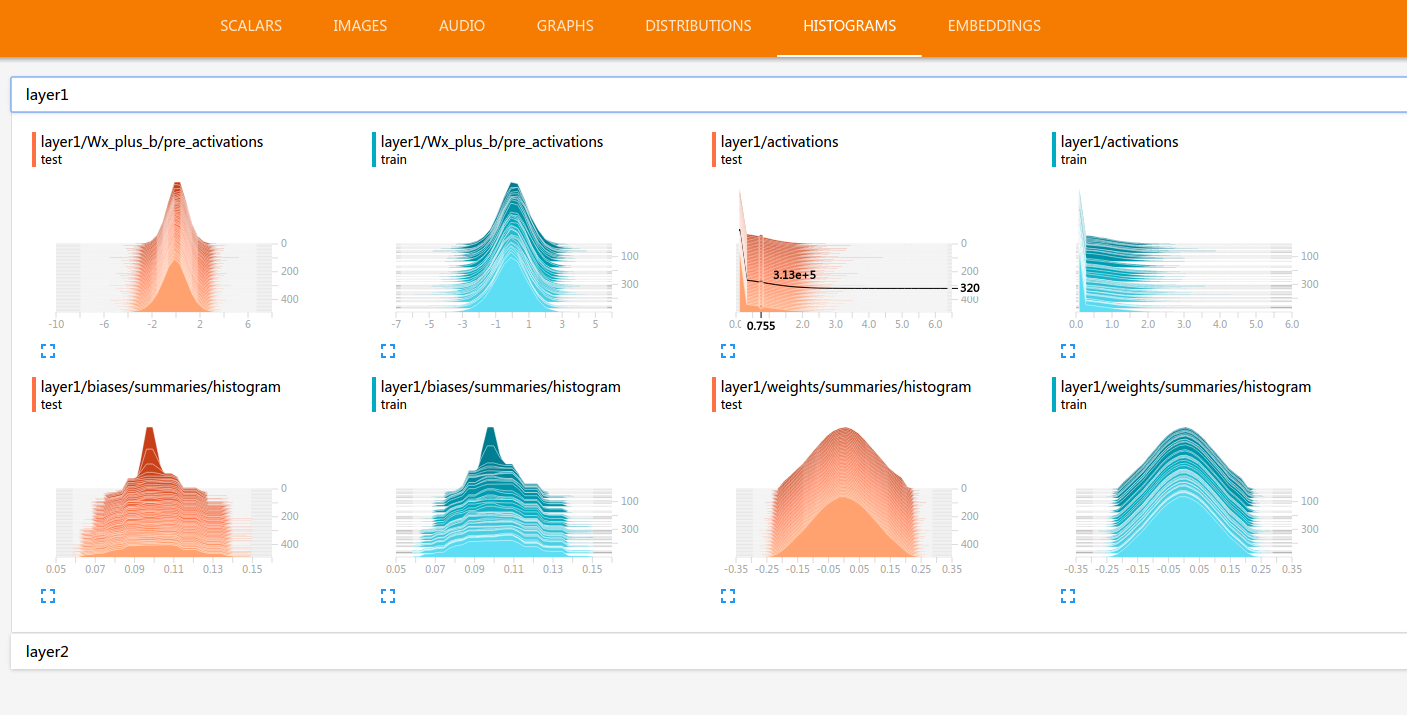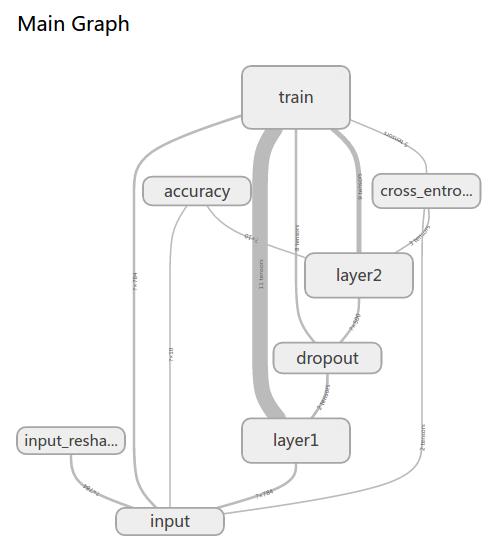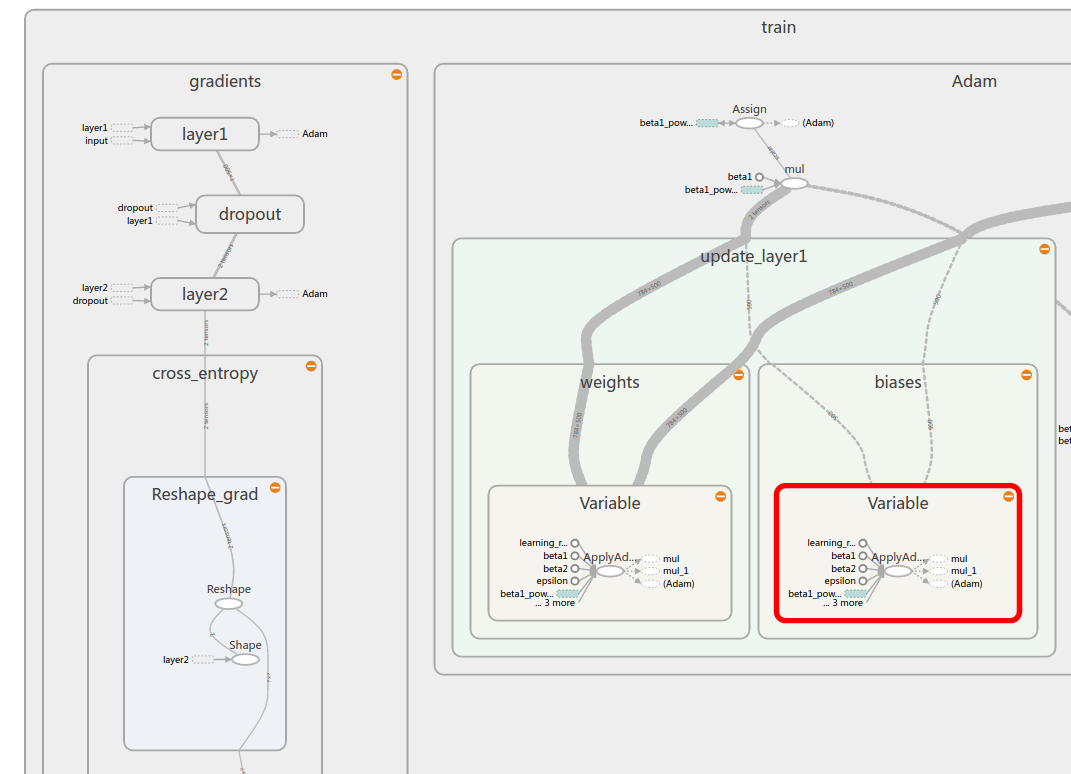下面是一个可视化的例子,网上还有一些其他版本的代码,在Tensorflow 2016年12月更新后需要修改才能使用。
参照这个例子,为上一篇随笔中的softmax添加了可视化(更新到上一篇)。
主要更新包括:
"tf.train.SummaryWriter": "tf.summary.FileWriter", "tf.scalar_summary": "tf.summary.scalar", "tf.histogram_summary": "tf.summary.histogram", "tf.audio_summary": "tf.summary.audio", "tf.image_summary": "tf.summary.image", "tf.merge_summary": "tf.summary.merge", "tf.merge_all_summaries": "tf.summary.merge_all",
运行可能会报错Couldn't open CUDA library libcupti.so.8.0,需要把下面路径加到环境变量或者编译器环境。
LD_LIBRARY_PATH=/usr/local/cuda-8.0/lib64:/usr/local/cuda-8.0/extras/CUPTI/lib64
# Copyright 2015 The TensorFlow Authors. All Rights Reserved. # # Licensed under the Apache License, Version 2.0 (the 'License'); # you may not use this file except in compliance with the License. # You may obtain a copy of the License at # # http://www.apache.org/licenses/LICENSE-2.0 # # Unless required by applicable law or agreed to in writing, software # distributed under the License is distributed on an 'AS IS' BASIS, # WITHOUT WARRANTIES OR CONDITIONS OF ANY KIND, either express or implied. # See the License for the specific language governing permissions and # limitations under the License. # ============================================================================== """A simple MNIST classifier which displays summaries in TensorBoard. This is an unimpressive MNIST model, but it is a good example of using tf.name_scope to make a graph legible in the TensorBoard graph explorer, and of naming summary tags so that they are grouped meaningfully in TensorBoard. It demonstrates the functionality of every TensorBoard dashboard. """ from __future__ import absolute_import from __future__ import division from __future__ import print_function import argparse import sys import tensorflow as tf from tensorflow.examples.tutorials.mnist import input_data FLAGS = None def train(): # Import data mnist = input_data.read_data_sets(FLAGS.data_dir, one_hot=True, fake_data=FLAGS.fake_data) sess = tf.InteractiveSession() # Create a multilayer model. # Input placeholders with tf.name_scope('input'): x = tf.placeholder(tf.float32, [None, 784], name='x-input') y_ = tf.placeholder(tf.float32, [None, 10], name='y-input') with tf.name_scope('input_reshape'): image_shaped_input = tf.reshape(x, [-1, 28, 28, 1]) tf.summary.image('input', image_shaped_input, 10) # We can't initialize these variables to 0 - the network will get stuck. def weight_variable(shape): """Create a weight variable with appropriate initialization.""" initial = tf.truncated_normal(shape, stddev=0.1) return tf.Variable(initial) def bias_variable(shape): """Create a bias variable with appropriate initialization.""" initial = tf.constant(0.1, shape=shape) return tf.Variable(initial) def variable_summaries(var): """Attach a lot of summaries to a Tensor (for TensorBoard visualization).""" with tf.name_scope('summaries'): mean = tf.reduce_mean(var) tf.summary.scalar('mean', mean) with tf.name_scope('stddev'): stddev = tf.sqrt(tf.reduce_mean(tf.square(var - mean))) tf.summary.scalar('stddev', stddev) tf.summary.scalar('max', tf.reduce_max(var)) tf.summary.scalar('min', tf.reduce_min(var)) tf.summary.histogram('histogram', var) def nn_layer(input_tensor, input_dim, output_dim, layer_name, act=tf.nn.relu): """Reusable code for making a simple neural net layer. It does a matrix multiply, bias add, and then uses relu to nonlinearize. It also sets up name scoping so that the resultant graph is easy to read, and adds a number of summary ops. """ # Adding a name scope ensures logical grouping of the layers in the graph. with tf.name_scope(layer_name): # This Variable will hold the state of the weights for the layer with tf.name_scope('weights'): weights = weight_variable([input_dim, output_dim]) variable_summaries(weights) with tf.name_scope('biases'): biases = bias_variable([output_dim]) variable_summaries(biases) with tf.name_scope('Wx_plus_b'): preactivate = tf.matmul(input_tensor, weights) + biases tf.summary.histogram('pre_activations', preactivate) activations = act(preactivate, name='activation') tf.summary.histogram('activations', activations) return activations hidden1 = nn_layer(x, 784, 500, 'layer1') with tf.name_scope('dropout'): keep_prob = tf.placeholder(tf.float32) tf.summary.scalar('dropout_keep_probability', keep_prob) dropped = tf.nn.dropout(hidden1, keep_prob) # Do not apply softmax activation yet, see below. y = nn_layer(dropped, 500, 10, 'layer2', act=tf.identity) with tf.name_scope('cross_entropy'): # The raw formulation of cross-entropy, # # tf.reduce_mean(-tf.reduce_sum(y_ * tf.log(tf.softmax(y)), # reduction_indices=[1])) # # can be numerically unstable. # # So here we use tf.nn.softmax_cross_entropy_with_logits on the # raw outputs of the nn_layer above, and then average across # the batch. diff = tf.nn.softmax_cross_entropy_with_logits(labels=y_, logits=y) with tf.name_scope('total'): cross_entropy = tf.reduce_mean(diff) tf.summary.scalar('cross_entropy', cross_entropy) with tf.name_scope('train'): train_step = tf.train.AdamOptimizer(FLAGS.learning_rate).minimize( cross_entropy) with tf.name_scope('accuracy'): with tf.name_scope('correct_prediction'): correct_prediction = tf.equal(tf.argmax(y, 1), tf.argmax(y_, 1)) with tf.name_scope('accuracy'): accuracy = tf.reduce_mean(tf.cast(correct_prediction, tf.float32)) tf.summary.scalar('accuracy', accuracy) # Merge all the summaries and write them out to /tmp/mnist_logs (by default) merged = tf.summary.merge_all() train_writer = tf.summary.FileWriter(FLAGS.log_dir + '/train', sess.graph) test_writer = tf.summary.FileWriter(FLAGS.log_dir + '/test') tf.global_variables_initializer().run() # Train the model, and also write summaries. # Every 10th step, measure test-set accuracy, and write test summaries # All other steps, run train_step on training data, & add training summaries def feed_dict(train): """Make a TensorFlow feed_dict: maps data onto Tensor placeholders.""" if train or FLAGS.fake_data: xs, ys = mnist.train.next_batch(100, fake_data=FLAGS.fake_data) k = FLAGS.dropout else: xs, ys = mnist.test.images, mnist.test.labels k = 1.0 return {x: xs, y_: ys, keep_prob: k} for i in range(FLAGS.max_steps): if i % 10 == 0: # Record summaries and test-set accuracy summary, acc = sess.run([merged, accuracy], feed_dict=feed_dict(False)) test_writer.add_summary(summary, i) print('Accuracy at step %s: %s' % (i, acc)) else: # Record train set summaries, and train if i % 100 == 99: # Record execution stats run_options = tf.RunOptions(trace_level=tf.RunOptions.FULL_TRACE) run_metadata = tf.RunMetadata() summary, _ = sess.run([merged, train_step], feed_dict=feed_dict(True), options=run_options, run_metadata=run_metadata) train_writer.add_run_metadata(run_metadata, 'step%03d' % i) train_writer.add_summary(summary, i) print('Adding run metadata for', i) else: # Record a summary summary, _ = sess.run([merged, train_step], feed_dict=feed_dict(True)) train_writer.add_summary(summary, i) train_writer.close() test_writer.close() def main(_): if tf.gfile.Exists(FLAGS.log_dir): tf.gfile.DeleteRecursively(FLAGS.log_dir) tf.gfile.MakeDirs(FLAGS.log_dir) train() if __name__ == '__main__': parser = argparse.ArgumentParser() parser.add_argument('--fake_data', nargs='?', const=True, type=bool, default=False, help='If true, uses fake data for unit testing.') parser.add_argument('--max_steps', type=int, default=500, help='Number of steps to run trainer.') parser.add_argument('--learning_rate', type=float, default=0.001, help='Initial learning rate') parser.add_argument('--dropout', type=float, default=0.9, help='Keep probability for training dropout.') parser.add_argument('--data_dir', type=str, default='data', help='Directory for storing input data') parser.add_argument('--log_dir', type=str, default='logs/mnist_with_summaries', help='Summaries log directory') FLAGS, unparsed = parser.parse_known_args() tf.app.run(main=main, argv=[sys.argv[0]] + unparsed)
到相应目录,运行
tensorboard --logdir=mnist_with_summaries
提示You can navigate to http://127.0.1.1:6006 ,便能进入TensorBoard。

